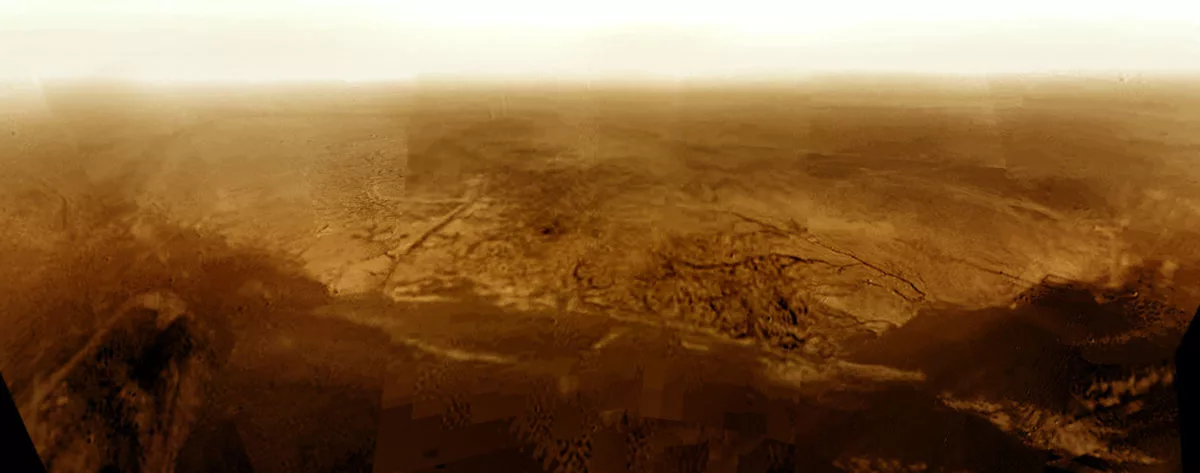
(Artist's concept of Dragonfly soaring over the dunes of Saturn's moon Titan. NASA/Johns Hopkins APL/Steve Gribben)
Dragonfly will push the boundaries of engineering and science as it explores Titan.
NASA has formally approved the robotic Dragonfly mission for full development, committing to a revolutionary project to explore Saturn's largest moon with a quadcopter drone.
Agency officials announced the outcome of Dragonfly's confirmation review last week. This review is a checkpoint in the lifetime of most NASA projects and marks the moment when the agency formally commits to the final design, construction, and launch of a space mission. The outcome of each mission's confirmation review typically establishes a budgetary and schedule commitment.
"Dragonfly is a spectacular science mission with broad community interest, and we are excited to take the next steps on this mission," said Nicky Fox, associate administrator of NASA's science mission directorate. "Exploring Titan will push the boundaries of what we can do with rotorcraft outside of Earth."
In the case of Dragonfly, NASA confirmed the mission with a total lifecycle cost of $3.35 billion and a launch date of July 2028. That is roughly twice the mission's original proposed cost and a delay of more than two years from when the mission was originally selected in 2019, according to NASA.
Busting the cost cap:
Rising costs are not necessarily a surprise on a mission as innovative as Dragonfly. After reaching Titan, the eight-bladed rotorcraft lander will soar from place to place on Saturn's hazy moon, exploring environments rich in organic molecules, the building blocks of life.
Dragonfly will be the first mobile robot explorer to land on any other planetary body besides the Moon and Mars, and only the second flying drone to explore another planet. NASA's Ingenuity helicopter on Mars was the first. Dragonfly will be more than 200 times as massive as Ingenuity and will operate six times farther from Earth.
Despite its distant position in the cold outer Solar System, Titan appears to be reminiscent of the ancient Earth. A shroud of orange haze envelops Saturn's largest moon, and Titan's surface is covered with sand dunes and methane lakes.
Titan's frigid temperatures—hovering near minus 290° Fahrenheit (minus 179° Celsius)—mean water ice behaves like bedrock. NASA's Cassini spacecraft, which flew past Titan numerous times before its mission ended in 2017, discovered weather systems on the hazy moon. Observations from Cassini found evidence for hydrocarbon rains and winds that appear to generate waves in Titan's methane lakes.
Clearly, Titan is an exotic world. Most of what scientists know about Titan comes from measurements collected by Cassini and the European Space Agency's Huygens probe, which Cassini released to land on Titan in 2005. Huygens returned the first pictures from Titan's surface, but it only transmitted data for 72 minutes.
Dragonfly will explore Titan for around three years, flying tens of kilometers about once per month to measure the prebiotic chemistry of Titan's surface, study its soupy atmosphere, and search for biosignatures that could be indications of life. The mission will visit more than 30 locations within Titan's equatorial region, according to a presentation by Elizabeth Turtle, Dragonfly's principal investigator at the Johns Hopkins University Applied Physics Laboratory.
"The Dragonfly mission is an incredible opportunity to explore an ocean world in a way that we have never done before," Turtle said in a statement. "The team is dedicated and enthusiastic about accomplishing this unprecedented investigation of the complex carbon chemistry that exists on the surface of Titan and the innovative technology bringing this first-of-its-kind space mission to life."
However, this high level of ambition comes at a high cost. NASA selected Dragonfly to proceed into initial development in 2019. Turtle's science team proposed Dragonfly to NASA through the agency's New Frontiers program, which has developed a series of medium-class Solar System exploration missions. The New Frontiers program has an impressive pedigree, beginning with the New Horizons mission that flew by Pluto in 2015, the Juno mission to Jupiter, and the OSIRIS-REx asteroid sample return mission.
Dragonfly's lifecycle cost of $3.35 billion will make it significantly more expensive than any of those missions.
When NASA chose Dragonfly in 2019, the mission had a cost cap of $850 million ($1 billion when adjusted for inflation) to get it to the launch pad. The budget limit didn't include the launch or costs to operate the Dragonfly spacecraft after launch. The costs originally under the budget cap have increased the $1 billion post-inflation figure to $2.1 billion, according to NASA.
Since 2019, NASA had to replan the Dragonfly mission multiple times due to funding constraints that limited how much the agency could spend on the project each fiscal year. Managers navigated the challenges imposed by the pandemic and supply chain issues. There was also an "in-depth design iteration," the agency said in a statement.
During this time, NASA directed managers in charge of Dragonfly to delay its launch from 2026 to 2027, which required the mission to change from a medium-lift to a heavy-lift launcher. As a result of this, NASA upped the funding for Dragonfly to pay for a bigger rocket. Dragonfly's updated launch window in July 2028 will still require a high-energy launch, likely on a SpaceX Falcon Heavy or a United Launch Alliance Vulcan rocket. NASA will likely select a launch provider for Dragonfly later this year.
Collectively, these pressures caused Dragonfly's lifecycle cost to grow to $3.35 billion, more in line with a flagship-class interplanetary mission than a cost-capped project. The two most recent New Frontiers missions came in between $1 billion and $1.5 billion, while Europa Clipper, NASA's next flagship planetary science probe, will cost around $5 billion.
NASA's commitment to Dragonfly also comes as the agency faces budget cuts. These reductions have hit the agency's planetary science division particularly hard. NASA is revamping plans for its big planetary flagship mission, Mars Sample Return, to try to rein in growing costs. The agency has postponed a call for scientists to propose concepts for the next New Frontiers mission that will follow Dragonfly.
Despite the higher costs, Dragonfly escaped cancellation. A major reason for this appears to be that NASA's budgetary limitations, and not any mismanagement from within the Dragonfly project, were responsible for a large share of the cost growth.
Assuming a launch in July 2028, Dragonfly will arrive at Titan in December 2034. Cocooned inside a heat shield and aeroshell, Dragonfly will enter Titan's atmosphere and deploy a parachute to slowly descend to the surface over the course of nearly two hours. Then, the quadcopter will settle onto the ground with its fixed landing skids.
At the surface, Titan's atmosphere is four times thicker than Earth's. This makes the process of getting to the ground a lot longer than a lander entering the atmosphere of Earth or Mars, but the higher air density should provide excellent flying conditions.

NASA officially greenlights $3.35 billion mission to Saturn’s moon Titan
Dragonfly will push the boundaries of engineering and science as it explores Titan.

NASA’s Dragonfly Rotorcraft Mission to Saturn’s Moon Titan Confirmed - NASA Science
NASA has confirmed its Dragonfly rotorcraft mission to Saturn’s organic-rich moon Titan. The decision allows the mission to progress to completion of final design, followed by the construction and testing of the entire spacecraft and science instruments. “Dragonfly is a spectacular science...







